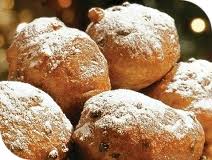 Do you enjoy doughnuts, cookies, and pancakes?
Thank the Dutch.
Do you enjoy doughnuts, cookies, and pancakes?
Thank the Dutch.
You can also thank them for pretzels, coleslaw, and waffles.
A Brief History of Dutch Food in New Netherland
Last week, I read Peter G. Rose’s article “A Taste of Change,” which investigated Dutch foodways in New Netherland.
According to Rose, New Netherlanders adapted traditional Dutch recipes to fit New World ingredients.
Many of the recipes the colonists adapted came from De Verstandige Kock (The Sensible Cook), a 17th-century Dutch cookbook.
For example, the 1683-edition of De Verstandige Kock contained a recipe for olie-koeken pastry that called for “2 pounds of wheat flour, not quite a pint of milk, half a small bowl of melted butter, a large spoon of yeast, mixed with a cup of the best apples, cut into small pieces, 2 pounds of raisins, 6 ounces of whole almonds” seasoned with a mixture of cinnamon, ginger, and cloves.
 New Netherland bakers and households did not have ready access to raisins and almonds so they adapted the recipe for the ingredients they had: eggs and butter.
New Netherland bakers and households did not have ready access to raisins and almonds so they adapted the recipe for the ingredients they had: eggs and butter.
The New Netherlanders created a richer dough to compensate for their lack of raisins and almonds.
Native American Influences on New Netherland Foodways
 Rose also found that New Netherlanders acculturated Native American foods such as pumpkins and corn to work with traditional Dutch recipes.
Rose also found that New Netherlanders acculturated Native American foods such as pumpkins and corn to work with traditional Dutch recipes.
However, the Dutch colonists adopted only one Native American dish into their culinary repertoire: sappaen, a corn mush dish.
According to Peter Kalm and other travelers, the New Netherlanders and their 18th-century descendants ate sappaen often.
Unlike the Native Americans, the Dutch ate sappaen with milk or buttermilk.
The Dutch served sappaen in a communal bowl. Once everyone took their serving, the Dutch dug a circle into the center of their sappaen to create a place for their milk. They ate half a spoon of milk and half a spoon of sappaen. The Dutch added more milk when they ran out and the size of the milk reservoir increased as they ate their sappaen.
 New Netherland-Inspired Dinner Party
New Netherland-Inspired Dinner Party
Needless to say, I grew quite hungry reading Rose’s essay on Dutch foodways.
In a 1-hour span, I wanted to eat cookies, pretzels, olie-koeken, and sappaen. Some of my hunger stemmed from a desire to know what sappaen and other Dutch pastries tasted like.
Therefore, I have decided to use my copy of [amazon_link id="081560503X" target="_blank" container="" container_class="" ]De Verstandige Kock[/amazon_link], which Rose has translated and republished, to throw a New Netherland-inspired dinner party in the next month or two.
I will be sure to blog about what it is like to cook these dishes and about how they taste.
 What Do You Think?
What Do You Think?
What is your favorite Dutch-inspired food?
*Picture shows traditional Dutch oliekoeken pastries.
